Chapter 14 Worms, Water and Biological Control
Soil life is very important in agriculture and, with this in mind, some seventeen years ago we planted worms, distributing them around with spades. We have continued to do so, but now we use two small worm machines, the first to be imported from New Zealand. One has a round wheel of about 3 feet (914 millimetres) in I diameter, and is pulled by a tractor. It has cleats on the wheel and two cutting edges on each side, and as the wheel revolves, it cuts the turf out about six inches (152 millimetres) wide.
The cleats chop it up about eight inches (203 millimetres) long and throw it out in turfs six inches (152 millimetres) wide and about three inches (76 millimetres) deep. These turfs, which are full of worms, are loaded on to a utility or tray of a tractor and taken to a new area, where there are none of the preferred worm species. (There are about 1800 species of earthworms.) There is another elevator that fits on the back of the utility or trailer with a manure box fitted to it. We place the turfs with the grass side down on the elevator, which carries them down to the grass and deposits them so both sides of the grass are together. This gives the worms a good chance to start multiplying.
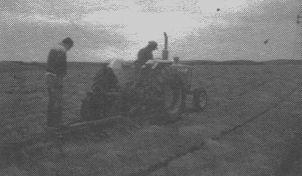
Distributing earthworms at Rushy Lagoon.
A little contraption triggers off the manure box, which puts a square metre of lime over the turf so that on every ten metres you automatically put on a metre of lime or dolomite. The lime is necessary, because you have to have a pH of 5.8 per cent before worms will really breed, although they might exist before then. At least, pasture worms will not thrive or breed unless the pH is about 5.8.
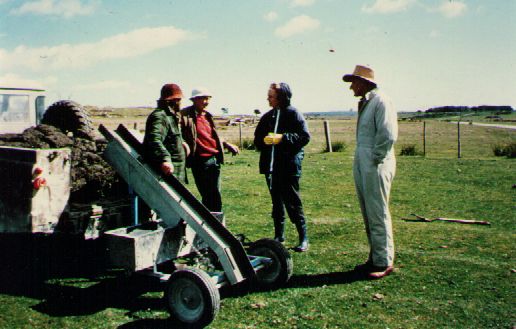
Turf cutting and distribution machine.
Dr Jo Springett and myself talking with two of our staff.
We have followed this method all through Wyambi, and the worms are doing a wonderful job. The earth is full of minerals and many of them are unavailable to plants because they are insoluble. However, after the minerals pass through the worm's body the worm casts are soluble. We have about four million worms per acre on our property in the areas of highest worm population, or 24 odd tons per acre or nearly 70 tonnes per hectare of worm casts providing soluble nutrients. The worm casts contain many times the nitrogen, phosphate and potash than the Surrounding soil.
The British Magazine 'New Scientist' maintains that earthworms keep the ground cooler in summer and warmer in. winter. This naturally greatly helps year-round growth of pastures. The magazine also claims that in Holland and Scotland, with the introduction of suitable earthworms, the numbers of sheep increased by 50%.
In 1842 Charles Darwin spread chalk over a specified area, and over a twenty-five year period the worms buried the chalk at an average of 5 millimetres per year or 20 centimetres in twenty-five years. Therefore Stones can be covered eight inches or 20 centimetres by earthworms in 25 years.
An interesting side-light is that cultivated worms give off odours and therefore native worms are far better for fishing according to the journal.
Where worms go down a foot to 15 inches (305 millimetres to 381 millimetres), the grass will follow the worm hole down, and the sides of the worm hole are covered with fine, good soil, encouraging the grass to root deeply and extract other minerals from the surrounding area.
It is really not much good spending $80,000 for a big tractor and $15,000 for a cultivator that cuts underneath the soil for 'deep-rooting,' and tens of thousands of dollars on fuel if you can get the worms to do the work for nothing! I know there are still places for mechanised deep cultivation but I believe we must, wherever possible, work in with Nature and do things cheaply, efficiently and well. In this way we benefit ourselves, and the state and nations benefit also.
There are probably a minimum of 2000 pounds weight of animals, including worms in an acre of soil. This is a greater amount than the animals running above it. If you have a thousand pounds weight of animals on top and you have two thousands pounds weight of animals underneath, you can imagine how live and thriving that soil is.It is self-mulching with the worms, which are the biggest of the animals, bringing up the goodness from below to the surface and distributing these as worm casts; the lining of their burrows is also soluble to the plants.
The soil life, made up of all types of bacteria and animals, with worms the biggest of the animals there, exhales gases and the leaves of the plants absorb these gases (really the breath of the animals) on the surface.
In observing this cycle, we can see another example of the valuable contribution of trees. Shelter belts stop the gases from being blown away and help the plants on the paddocks absorb them better. Beattie of the C.S.I.R.O. years ago wrote some very good articles on this. Good soil life keeps the soil warm, enabling plants to grow in winter-time.
I remember seeing an example of this when my grandfather used to feed cattle down a steep bank, which was against the westerly winds and was cold. But because he fed the cattle there the soil became very rich with mulching and was full of wonns. In the middle of winter this bank was so rich and warm with animal life beneath it that the grass would grow right throughout the winter, far quicker than up on the otherareas.
With irrigation you do increase the amount of soil life and the density of the worm population more quickly. However, in heavy soil with concentrated strip feeding, cattle can depress the worm population, as Dr. Tim Kingston has proved.
Worms go into hibernation in the dry weather, reducing themselves to round balls of tissues, which you can barely see unless you really understand and look for them. I never understood what they looked like until a New Zealand doctor, Jo Springett, showed them to me. She also told me that worms, being hermaphrodites (i.e. possessing both male and female organs), couple once a year, head to tail! That is quite an interesting little factor; I had not seen this until she pointed it out to me.
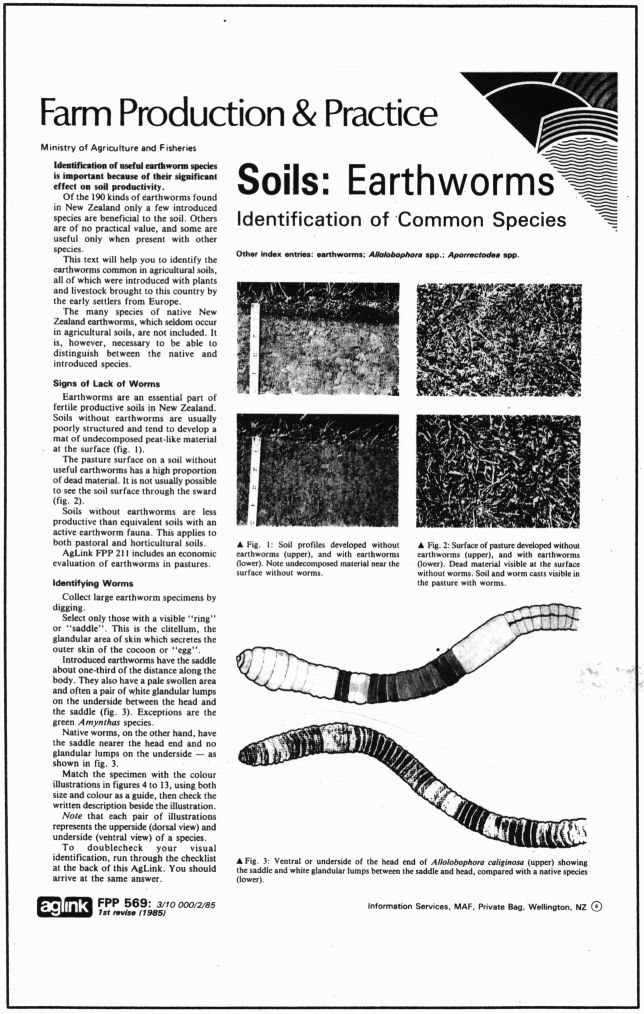
MAF Earthworm pamphlet
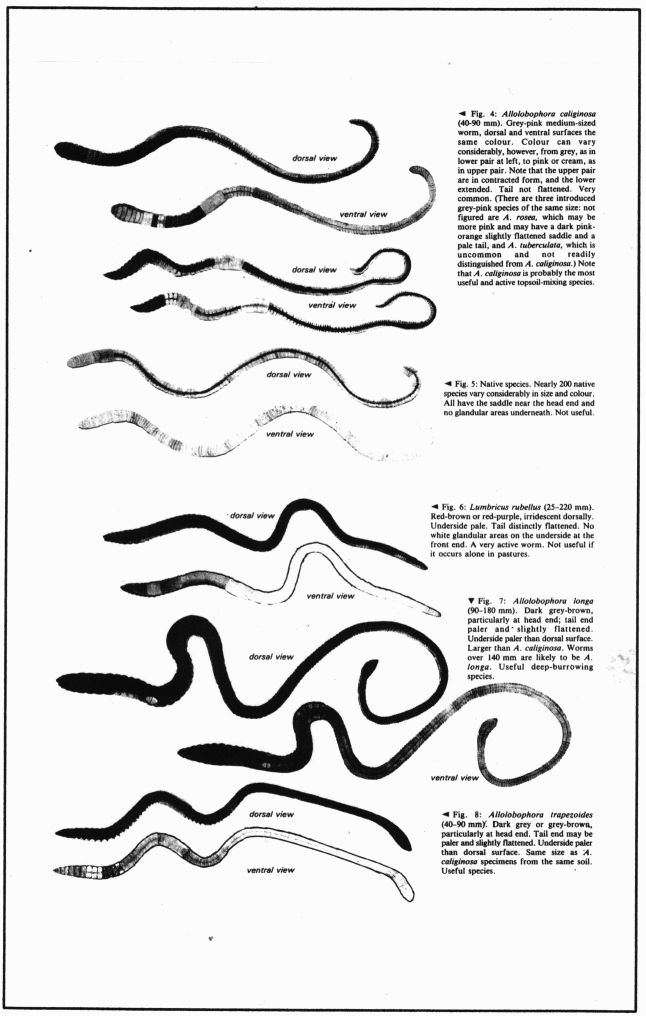
MAF Earthworm pamphlet
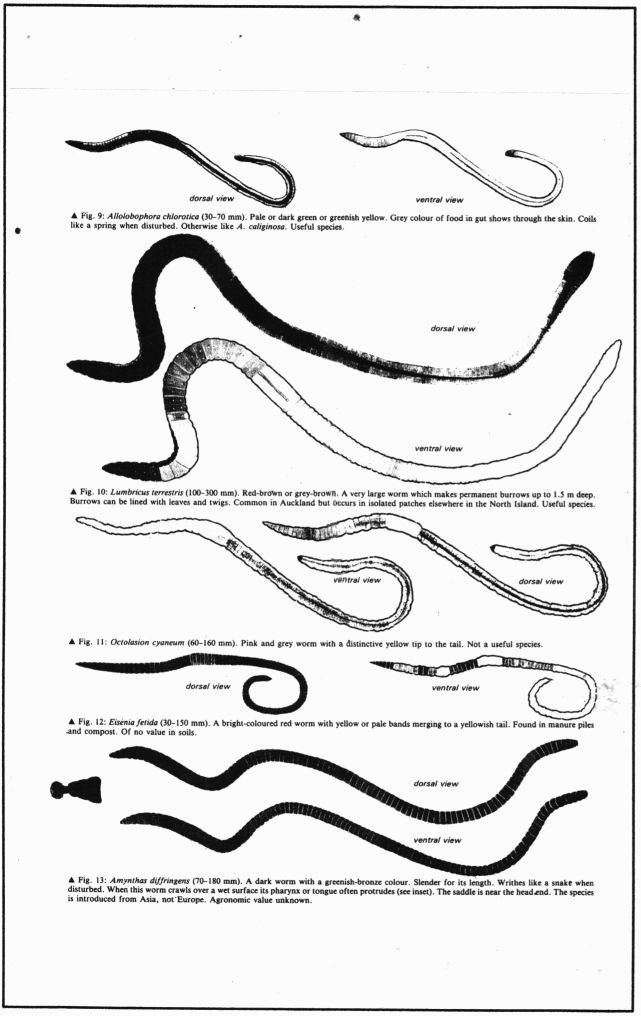
MAF Earthworm pamphlet
More than 20 years ago I went to Ruratura College in New
Zealand, and mentioned that I had read in pamphlets that worms increased
productivity of a new area up to 70 per cent without artificial
manure. The college principal seemed amused at the idea and said that
in his opinion there was no truth in it at all. However, when I returned
home I asked his Director of Entomology whether it was possible to
get worms of the right type which would increase pasture productivity
by 25 percent. I had broken down the percentage to be on the safe side.
He replied, Actually, you can get 70 per cent
. So the pamphlets I
had read and quoted were correct.
I think it was in 1982 that the New Zealand Government asked for a report on how good worms were for the soil, and the N.Z. Journal of Agriculture April 1984 published quite a lot about it. In short, the Journal said that, with the right type of worms, throughout New Zealand the farmers would gain about $500, 000,000 a year in productivity that had cost them nothing apart from putting the worms in. The productivity, it added, increased by 25 percent, on an average, with up to 70 on new ground.
This was a fantastic statement. A province where the worms had been used for years had stated that the policy of using worms had proved a winner, as for every dollar spent there was a gain of at least three dollars. This was quite a remarkable finding by the Commission which reported back to the New Zealand Parliament. Today, if you can get one per cent increase in production from natural methods it is a real breakthrough. There is no doubt that biological control has a future.
Many of the things we have advocated are now becoming official. Some of the latest interesting policy items now causing public interest include a new realisation of the benefit of worms from an official viewpoint. In the past I tried to get the C.S.I.R.O. interested in research, to check which species of worms were the best for our particular crops and properties.
I understand there are about 1800 different species of identifiable worms on our planet, and more are continually being discovered. The species found to be most useful in New Zealand pastures are Allolobophora caliginosa and A. longa which burrows very deeply.
Following the purchase of Rushy Lagoon various television networks were interviewing me about many things and often earthworms came up in the interview. I have two daughters living in Brisbane. Helen is a Qantas executive and Mary lectures in Chinese Literature at the Griffith University. They rang me up and said, 'Dad, don't talk so much about worms on T.V.' I guess they wanted Dad to sound reasonably intelligent!! I have included a copy of a pamphlet for identification of earthworms, because so many people require this information.

Daughters, Dr. Mary Farquhar and Helen Shield presenting
me with a 'welcome' sign for our new office - 1987.

I am discussing my sign with visitors.
We have taken poetic' licence in giving the worms different sexes.
The 'lady' worms have ribbons on their heads, whereas the two 'male' worms on each end have bow ties!
The 16 on the end represents the human workforce.
Probably by now there could be 100,000,000,000 worms, enough to pay off the national debt if sold for $1 each.
It is pleasing that in the 1988-89 Summer Edition, C.S.I.R.O. Rural Research 141 circulated throughout Australia devoted 25 per cent of the pamphlet to worms. This was, in my memory, the first time this had happened. I think it is worth-while reading some of the quotes from this pamphlet. The quotation on the following page shows the results obtained on Rushy Lagoon, released in May, 1989.
Several years after the late Dr. Keith Barley and colleagues, of CSIRO, inoculated irrigated grass-clover pastures with additional earthworms (A. caliginosa), at Denilquin, N.S. W., other scientists found that pasture mats were reduced from 72,300 kg per ha in non-inoculated pasture to 7,600 kg per ha in the worm-inoculated areas.
Overseas scientists have reported massive increases in the yield of crop plants grown in experimental pots when earthworms are added - an average increase of 83% for millet, lima beans, soybeans, wheat, and hay in one study; in anothe,; total dry matter prodaction of grass, wheat, and clover increased by 287%, 111%, and 877% respectively when earthworms were present, and so on. However, yield increases of this magnitude are unlikely to be achieved in cropland.
We have already noted the beneficial effects of deep-burrowing earthworms on barley crops grown in the field.
Earthworms are emerging as a useful biological tool in the management of sugar-cane in Queensland.
Experiments overseas have shown that populations of these worms can ingest up to 300 tonnes ofsoilper hectareperyear andthat, by the time it passes through the worm's gut, the soil material (in worm casts) is considerably modified.
It is more abundant under clover pastures than in its natural habitat of virgin bush. Its population achieve a biomass of 300 - 960 kg per ha in pasture soils - some 6 - 18 times the weight of sheep stocked on those pastures!
Dr. Mike Temple-Smith and Dr. Tim Kingston's research at our Rushy Lagoon property, reported in May 1989, showed a 75 per cent increase in pasture production with the addition of A. Caliginosa earthworms.
We use our natural reserves of water, worms, herbs and shelter trees to the utmost. If we wish to operate economically this is what we must do. As I have mentioned before, I still believe Tasmania could use its water resources to greater advantage. Many people believe that water is ideal in a hot, dry climateand that if you have a good rainfall you don't need it so much. That is not really correct.
In America they do not use so much inigation in the drier areas because they have to use a lot of expensive water to produce a crop. In Maine, where they have a very big rainfall in the eastern areas of the United States, they usea tremendous amount of water just to top up their crops. Then in Sacramento Valley, in California, they use a lot of water from the rivers, which is cheap, for flood irrigation, but generally they find it cheaper just to top up their crops.
In Tasmania, for instance, in dry land farming a crop of 10 tonnes of potatoes to the acre is considered good, but when farmers top up with irrigation and use the right manures they grow 20 to 30 or even 40 tonnes to the acre. But the topping up with irrigation is vital. This also applies to any other vegetable crop grown.
A controlled water supply also helps to correct the fluke problem in our stock. Fluke thrives in very clear water with a high Ph. Some of Rushy Lagoon has water from the sand hills with a very high Ph, for it is beautifully clean water, but the fluke was quite a problem in this area, and it extended a bit to other areas of the property.
However, by putting black acid ti-tree water right through Rushy from the Mt. Cameron water race we have countered this fluke problem a lot. It has been found throughout Australia that fluke does not thrive where there is black acid, high tannin ti-tree coloured water.
So this is another benefit we have gained from working with Nature. Surely this is far better than using chemicals or sprays or anything like that. I feel our future lies in biological control.
Information released on May 17, 1989, by the D.S.I.R. in New Zealand shows that tannin-rich plants can make sheep grow 30 per cent more wool!
Another factor that has helped us considerably is correcting the selenium deficiency. Selenium deficiency has always been a problem in many parts of Tasmania, as itis in many other areas of Australia. We include selenium in sheep drenches and we now have reasonable selenium levels in our sheep. The water race runs many kilometres through old mine workings and this could be where we are gaining extra minerals to help our sheep and cattle.
There was a trace element deficiency in most of the coastal country in North Eastern Tasmania. As mentioned, when we sow down a new area, we put cobalt and copper oxide in with our fertiliser. We are the only ones in the State that ask for a copper oxide mix, instead of a copper sulphate mix, because we think it lasts longer and the plants only use it as required. We think it has two or three times the life of copper sulphate on the pasture at no extra cost. Our cattle have all nice rich red coats; a shortage of copper is indicated when a Hereford's coat is a light colour or when an Angus has a steely grey-coloured coat. Cattle's eyes often weep when there is a shortage of cobalt and clover plants cannot produce the nitrogen nodules without cobalt. All these factors - worms, fluke prevention, extra wool from tannin-rich plants, etcetera - are all parts of sustainable agriculture.
It is interesting that Mr. Kern, Federal Minister for Primary
Industries, foresees the necessity for sustainable agriculture. Here is
an extract from The Australian of May 30,1989: Australia and many
other countries face a catastrophe on a scale yet undreamt of if we fail
to develop sustainable farming systems
, the Minister for Primary
Industries and Energy, Mr. Kerin, warned yesterday.'
It is pleasing that Australia is now really concerned officially that where possible we should practise sustainable agriculture. While Australian farmers have been very efficient, governments must help and show a lead in these matters. I feel sure that we will see ever-increasing official awareness of every phase of biological control of disease where practicable and that more sustainable agricultural practices will be adopted.
When we travel overseas we find that everyone is becoming very environment- and health-conscious. They know their own and their families' health is the most important thing in the world.
We have the capacity to produce foods and materials that will command premium prices on a generally polluted world market. We can all look forward to the year 2000, and I am sure our progress will continue. We will always have a few little headaches and something to complain about, but we really have a great future, as long as we work with Nature, and the environment generally, for the well-being of the world as a whole.
We must think seriously of doing things that are helpful environmentally and pleasing to the eye, but yet of a practical nature, if the world is to sustain double its population in 39 years' time, as is forecast.
I remember years ago, when not so many citizens had lovely
gardens, admiring Ron Beattie's garden at Scottsdale, Tasmania,
especially his flowering cherries. He said, I made a mistake! A
cherry tree also is very nice when in blossom, and when it is later laden.
with ripe cherries it is far from unsightly!
When the world's population increases still further, possibly the State, municipal councils, hospitals and other bodies should plant walnut trees instead of plane trees and cherry trees instead of flowering cherries.
We must just keep up and even be in front with progressive ideas if we are to play our part in feeding future generations. It would help hungry people if they could picknuts or fruit from trees in parks or on the streets in the same way as the Arabs pick dates in the desert. We are already planting hundreds of walnut trees at Rushy Lagoon to help keep the. flies at bay, as well as providing nuts to eat.
And speaking of flies, the blow fly pest is being tackled biologically in a research project on Flinders Island. We had a visit from Texas farmers we met in Alaska, and they told us that 12 years ago they had a screwtail fly problem there. They controlled it biologically by releasing sterile male flies with affected eyesight in each area.
When I heard that the Australian Meat and Livestock Corporation had withdrawn from the Flinders Island project, I wrote to the Wool Board and they had already given about $65,000 to keep it going. Considering that blow flies do some $160,000,000 worth of damage each year to the wool industry that contribution was nothing, but at least the Wool Board has done something. I wrote to the various departments and boards and this year it has been announced that $4,000,000 is being spent on the blowfly project on Flinders Island, and that it will be extended to other areas.
Even if it is not wholly successful, it will help to reduce the number of blowflies, which are a big problem when the sheep are thin. A few blow flies around thin sheep are a bigger menace than a lot of them around healthy sheep. The blue green-backed blow fly does the most damage.
As I have said before, the world is now becoming very health-conscious, and we must do all we can to please our customers if we are to keep them. For instance, they have shown they do not want hormones in meat, nor do they want residues in vegetable crops.
The shocking escalation of crop spraying with chemicals which are harmful to the environment will have to stop. Unfortunately, we do not know they are harmful until after they have been used.
Fortunately, it is possible to get sprays which are safe, and we are now growing pyrethrum in Tasmania. We understand this is safe to use, so it is a great step forward. Admittedly, we must use all available scientific information and use technology to our advantage, but we still have to be careful with what we use.
Additives must not go into the food chain, and if we are sensible and ensure that our produce is free from additives harmful to the world's food chain, Australian and Tasmanian producers in particular, can look forward to a great future.
We have in Tasmania some of the cleanest air and the best non-polluted water in the world, and we must keep it that way. Unfortunately, some of our streams have been polluted, and their cleaning up has to be our first priority. It is 200 years since white settlement in Australia and we have done a lot of good things. But, on the other hand, we have done many things which are not in the best interests of our country or mankind.
It has just been announced that Holland has given their growers five years to reduce pesticides by 50 per cent and then to be reduced by another 20 per cent. The rest of Europe and the world will soon follow this trend.